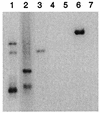Small tumor virus genomes are integrated near nuclear matrix attachment regions in transformed cells
- PMID: 11711624
- PMCID: PMC116130
- DOI: 10.1128/JVI.75.24.12339-12346.2001
Small tumor virus genomes are integrated near nuclear matrix attachment regions in transformed cells
Abstract
More than 15% of human cancers have a viral etiology. In benign lesions induced by the small DNA tumor viruses, viral genomes are typically maintained extrachromosomally. Malignant progression is often associated with viral integration into host cell chromatin. To study the role of viral integration in tumorigenesis, we analyzed the positions of integrated viral genomes in tumors and tumor cell lines induced by the small oncogenic viruses, including the high-risk human papillomaviruses, hepatitis B virus, simian virus 40, and human T-cell leukemia virus type 1. We show that viral integrations in tumor cells lie near cellular sequences identified as nuclear matrix attachment regions (MARs), while integrations in nonneoplastic cells show no significant correlation with these regions. In mammalian cells, the nuclear matrix functions in gene expression and DNA replication. MARs play varied but poorly understood roles in eukaryotic gene expression. Our results suggest that integrated tumor virus genomes are subject to MAR-mediated transcriptional regulation, providing insight into mechanisms of viral carcinogenesis. Furthermore, the viral oncoproteins serve as invaluable tools for the study of mechanisms controlling cellular growth. Similarly, our demonstration that integrated viral genomes may be subject to MAR-mediated transcriptional effects should facilitate elucidation of fundamental mechanisms regulating eukaryotic gene expression.
Figures




Similar articles
-
Nuclear matrix attachment regions of human papillomavirus type 16 point toward conservation of these genomic elements in all genital papillomaviruses.J Virol. 1998 May;72(5):3610-22. doi: 10.1128/JVI.72.5.3610-3622.1998. J Virol. 1998. PMID: 9557642 Free PMC article.
-
[Clonal expansion and genomic characterization of the human T-cell lymphotropic virus type I during the integration process in adult T-cell leukemia/lymphoma].Biomedica. 2009 Jun;29(2):218-31. Biomedica. 2009. PMID: 20128347 Spanish.
-
Impact of transforming viruses on cellular mutagenesis, genome stability, and cellular transformation.Environ Mol Mutagen. 2005 Mar-Apr;45(2-3):304-25. doi: 10.1002/em.20088. Environ Mol Mutagen. 2005. PMID: 15645440 Review.
-
Detection of oncogenic virus genomes and gene products in lung carcinoma.Br J Cancer. 2005 Feb 28;92(4):743-6. doi: 10.1038/sj.bjc.6602409. Br J Cancer. 2005. PMID: 15700034 Free PMC article.
-
Gene expression of genital human papillomaviruses and considerations on potential antiviral approaches.Antivir Ther. 2002 Dec;7(4):219-37. Antivir Ther. 2002. PMID: 12553476 Review.
Cited by
-
Cancer predisposition in diabetics: risk factors considered for predictive diagnostics and targeted preventive measures.EPMA J. 2010 Mar;1(1):130-7. doi: 10.1007/s13167-010-0015-4. Epub 2010 Mar 11. EPMA J. 2010. PMID: 23199047 Free PMC article.
-
Association Between Simian Virus 40 and Human Tumors.Front Oncol. 2019 Jul 25;9:670. doi: 10.3389/fonc.2019.00670. eCollection 2019. Front Oncol. 2019. PMID: 31403031 Free PMC article. Review.
-
HBV DNA Integration: Molecular Mechanisms and Clinical Implications.Viruses. 2017 Apr 10;9(4):75. doi: 10.3390/v9040075. Viruses. 2017. PMID: 28394272 Free PMC article. Review.
-
Modulation of chromatin by MARs and MAR binding oncogenic transcription factor SMAR1.Mol Cell Biochem. 2010 Mar;336(1-2):75-84. doi: 10.1007/s11010-009-0262-7. Epub 2009 Oct 3. Mol Cell Biochem. 2010. PMID: 19802523
-
Human papillomavirus type 16 E2 protein has no effect on transcription from episomal viral DNA.J Virol. 2003 Feb;77(3):2021-8. doi: 10.1128/jvi.77.3.2021-2028.2003. J Virol. 2003. PMID: 12525636 Free PMC article.
References
-
- Altschul S F, Gish W, Miller W, Myers E W, Lipman D J. Basic local alignment search tool. J Mol Biol. 1990;215:403–410. - PubMed
-
- Batzer M A, Alegria-Hartman M, Deininger P L. A consensus Alu repeat probe for physical mapping. Genet Anal Tech Appl. 1994;11:34–38. - PubMed
-
- Bode J, Benham C, Knopp A, Mielke C. Transcriptional augmentation: modulation of gene expression by scaffold/matrix-attached regions (S/MAR elements) Crit Rev Eukaryot Gene Expr. 2000;10:73–90. - PubMed
Publication types
MeSH terms
Grants and funding
LinkOut - more resources
Full Text Sources
Miscellaneous

